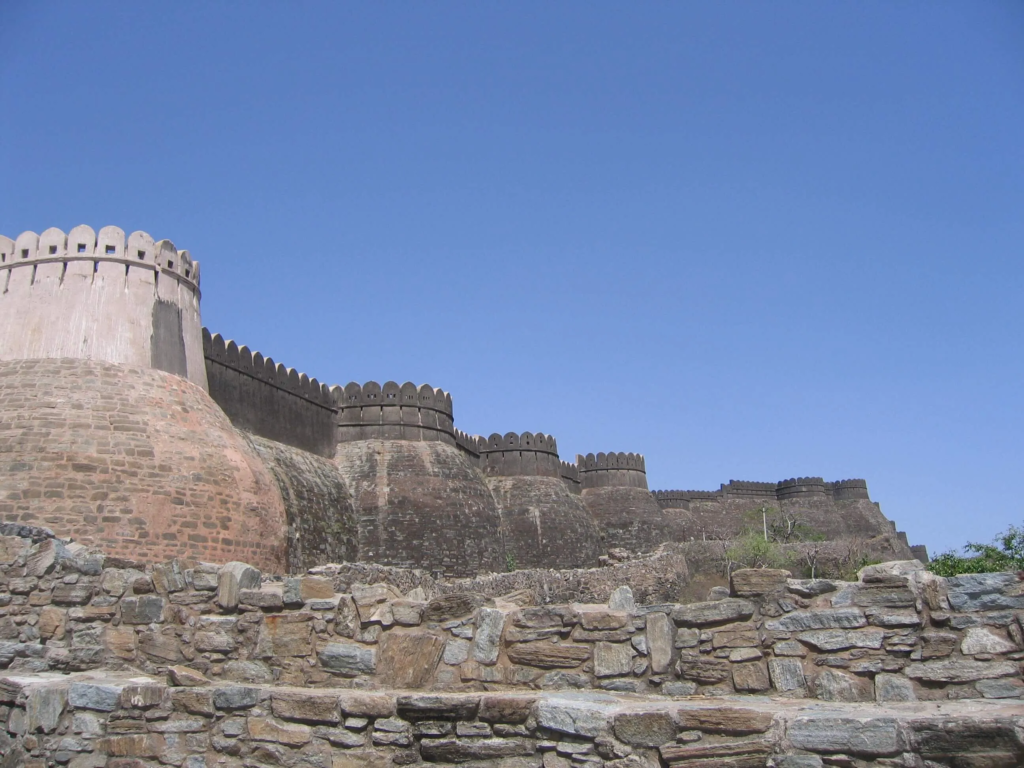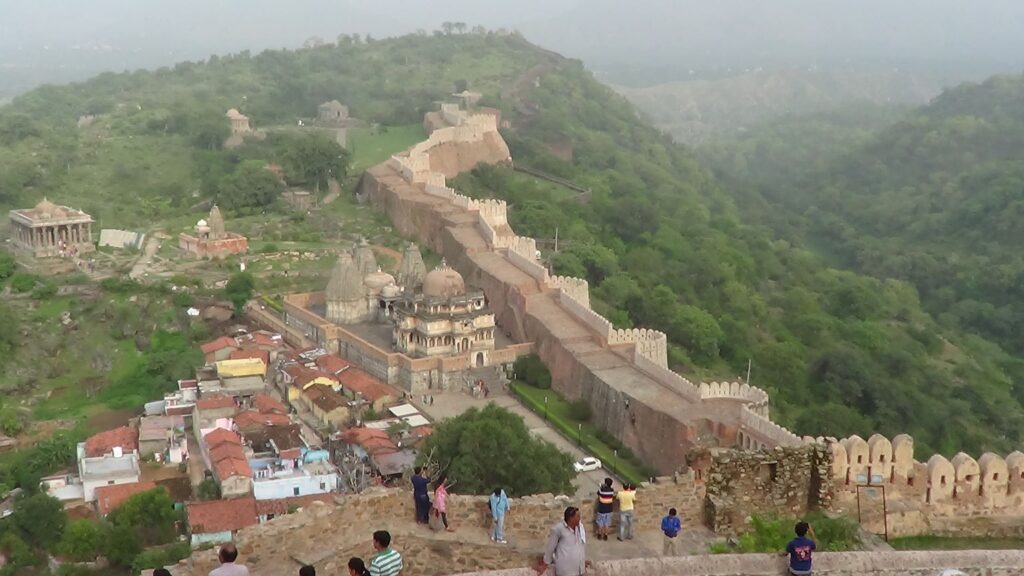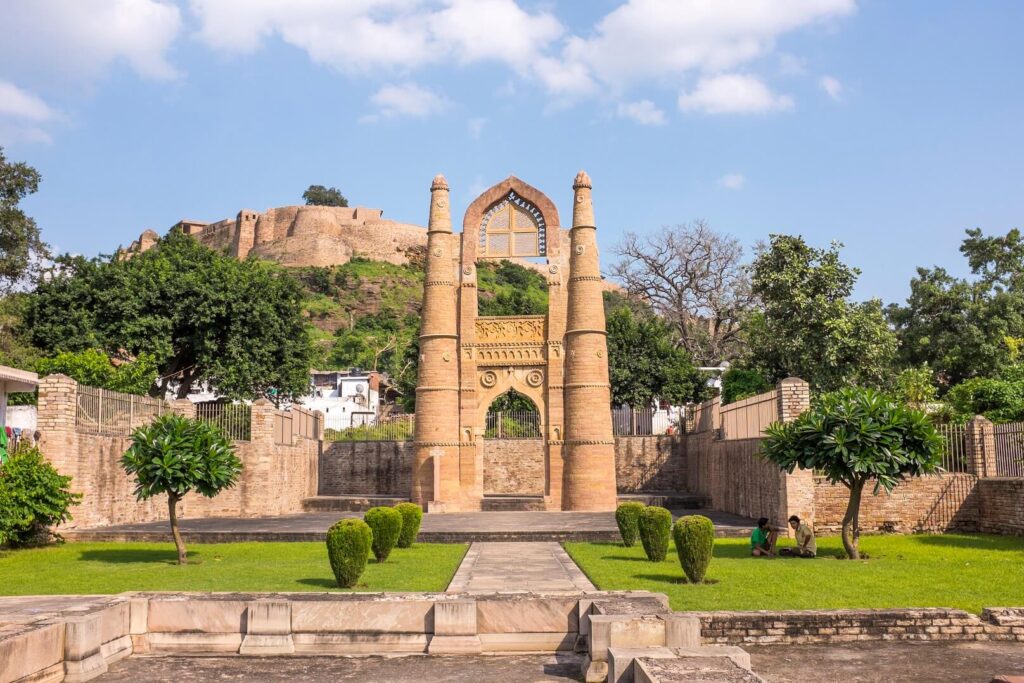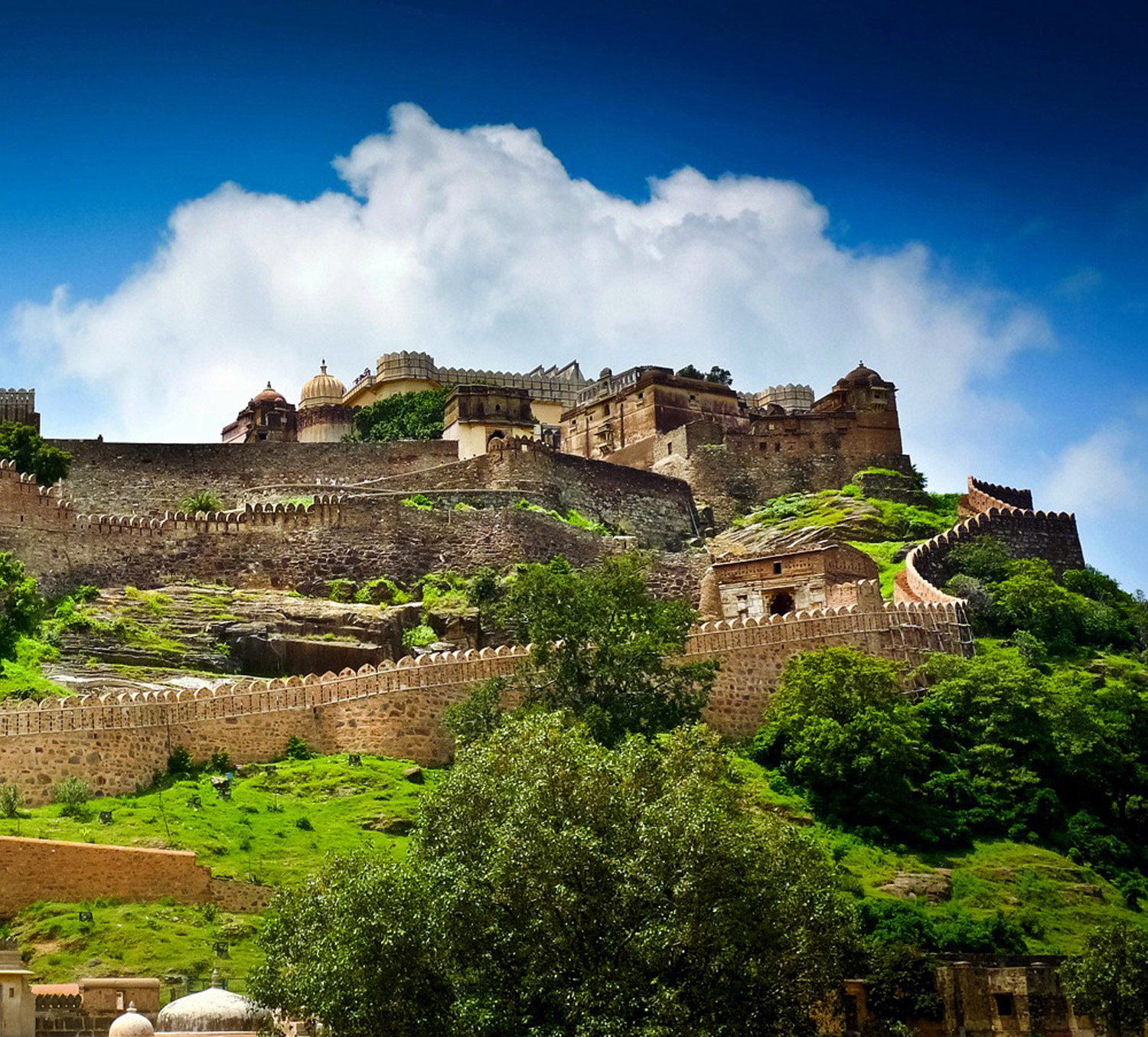Introduction
Rajasthan – just the name evokes images of magnificent forts, royal palaces, pristine lakes, endless deserts, vibrant turbans, and flavorful cuisine. Among its enchanting forts lies Kumbhalgarh Fort, nestled in the Rajsamand district near Udaipur. Known for its expansive walls weaving through the peaks of the Aravalli range, Kumbhalgarh Fort stands as a testament to Rajasthan’s rich heritage.
Constructed in the 15th century, Kumbhalgarh Fort is one of Rajasthan’s six hill forts, celebrated as the ‘Great Wall of India’ for its remarkable 36-kilometer perimeter. Recognized by UNESCO, it boasts the world’s second-longest wall, stretching 36 kilometers atop the Aravalli range, 1,100 meters above sea level. This architectural marvel, attributed to Rana Kumbha and overseen by renowned architect Mandan, showcases intricate craftsmanship and engineering prowess.
Legend holds that Kumbhalgarh Fort was erected upon the remnants of an earlier structure associated with Jain Prince Samprati from the 2nd century BC. Its construction faced numerous challenges, overcome by the dedication of Rana Kumbha and the sacrifice of a noble soul. The fort’s grandeur embodies the valor of the Rajputs and serves as the birthplace of Maharana Pratap, the revered 13th king of Mewar.
Strategically positioned on a hilltop, Kumbhalgarh Fort served as a formidable barrier between the Mewar and Marwar regions, offering protection against enemy attacks. Its imposing walls, dotted with approximately 360 temples, including 300 Jain temples, reflect the region’s rich cultural heritage.

The allure of Kumbhalgarh Fort transcends borders, attracting visitors from around the globe. Its architectural splendor and historical significance make it a symbol of Rajasthan’s greatness, yet its story remains undiscovered by many.
The Architecture of Kumbhalgarh Fort
Although this fort is claimed as a Heritage site sadly, it is less popular than the Amer forts and Jaisalmer forts. It is mostly because the fort is located 90kms north and you can feel the road swinging as you move at a higher altitude. After all the horror experienced as you move upwards, a faint glimpse of the fort will surely leave you in awe.
The architecture of Rajasthan was built in the Rajput military hill architectural style with a defence mechanism owing to its mountainous location.
A Sneak Peek into the Fort
You will be welcomed with giant, rusty, battlemented walls accompanied by a long hill range that will take you to the palace. As you enter the fort and take a few temples to the left, you reach a large gateway that takes you to the palace complex.

As you walk up the stairs, you will be covered with thick clouds and that’s the ‘Badal Mahal’. You will surely get mesmerized with the elaborate patterns of elephants fighting and aesthetic sculptures that are modified and added by a generation of rulers.
As you pass through several courtyards, small shrines, empty rooms and some troops of monkeys silently munching; there you have an incredible panorama view to yourself. Feel the cold breeze coming from the forests and explore everything from the hill-top vantage point to the countryside.
It is an endless 36 km walk coupled with 360 Hindu and Jain temples, hamlets of houses, cenotaph (or royal chhatris), wells (or baoris), water reservoirs, thick vegetation and small ridges that make the fort look pleasant and full of life. Stay at Kumbhalgarh hotel to enjoy this enchanting view.
A Detailed Insight to Kumbhalgarh
There are 7 imposing gates known as ‘Pols’ that are guarding all the entries of the fort. These huge sturdy rounded batons proclaim the Rajput supremacy and are ancient defence mechanisms. You can enter the fortress through the Aret Pol, Halla Pol, Hanuman Pol, Ram Pol and Vijay Pol.
While the palace complex can be approached through three gateways- Bhairon Pol, Nimboo Pol and Paghra Pol. The Danibatt Pol in the east connects Mewar from Marwar.
The ramp inside the fort takes you straight to the top of the hill and you will probably have an adventurous experience as you walk past the zig-zag path.
The hurdles are made intentionally to make it difficult for the enemy’s elephants and horses to run fast. There were many traps on the way made to catch hold of the invaders.
Dedicated to Lord Shiva, the Neelkanth Mahadev Temple located in an isolated hill in Alwar, which is another eloquent temple with its epic round-shaped dome, carved ceiling aloft 24 pillars, 5-feet high lingam. It is a treat to the eyes and an elixir for the soul.
The fort has so much to it, which is still untouched. The picturesque Kumbha palace, Badal Mahal, temples that speak about the bravery and the unblemished legacy left behind by the early Rajputs. After this, let’s take you on a trip to the Badal Mahal.

Built by Rana Fateh Singh, this spectacular palace is the highest point of the fort. The two-storeyed floating palace is divided into two interconnected distinct portions- Zenana Mahal and Mardana Mahal.
While the Zenana Mahal or women’s quarter has small sandstone screens (jalis) through which you can watch the outside world. If you are an artist, then you will be thrilled to watch the beautifully decorated wall paintings hung on the old walls.
It would not be more than an adventure to climb up to the terrace through narrow stairs and then finally experience the cloud covered mahal. The rooms still retain its 19th-century charm with pastel-coloured murals and beautifully textured turquoise, green and white schemed walls.
Some of the rooms might be in shambles but the view there is epic. If you have been lucky enough to reach there in the evening, then you would be able to see the sunset as it dooms over the landscape and makes it look so unreal.
The palace is not as huge nor ostentatious as the other palaces in Jodhpur and Udaipur, but when you enter the central courtyard with large windows, you will find yourself in heaven. The fresh lush green valley coupled with the glow of the setting sun will surely give you the best selfies.
Thrill-seekers, rejoice! Embark on a heart-pounding jeep safari through the Kumbhalgarh Wildlife Sanctuary, a haven teeming with diverse wildlife. Spot majestic leopards, elusive sloth bears, and a vibrant array of birds like crested serpent eagles and Indian grey hornbills as you traverse the rugged Aravalli landscape. Book safaris in advance through the Rajasthan Forest Department or reputable tour operators to ensure availability & greater experience.
For an adrenaline rush unlike any other, embark on a zipline adventure across the valleys surrounding the fort. This will take you in breathtaking panoramic views of the Aravalli landscape.
Amidst the rugged terrain of the Aravalli Range, travelers can immerse themselves in the natural beauty of the landscape while exploring the fort’s surroundings. Cultural aficionados can witness the captivating light and sound show, showcasing the fort’s storied past through a mesmerizing spectacle of lights and narration.
Apart from the fortress & adventures, Kumbhalgarh offers a plethora of attractions for visitors to explore. The scenic Hammeripal Lake, home to thousands of African Catfish, provides a tranquil retreat amidst the rugged terrain. Visitors can also explore nearby temples and structures, offering insights into the region’s rich cultural heritage.

Immerse yourself in the vibrant culture of Kumbhalgarh by indulging in local cuisine, shopping for traditional handicrafts, and participating in cultural festivals and events. From colorful turbans to intricate jewelry, the local markets offer a treasure trove of Rajasthani craftsmanship. Don’t miss the opportunity to witness traditional dance performances and folk music, showcasing the rich cultural heritage of the region.
No visit to Kumbhalgarh is complete without sampling the delectable local cuisine. From traditional Rajasthani thalis to mouthwatering street food, the region offers a gastronomic delight for every palate. Don’t forget to try the famous Dal Baati Churma, Gatte ki Sabzi, and Ker Sangri, accompanied by piping hot rotis and fragrant rice.
When planning your visit to Kumbhalgarh, consider the best time to explore this historic marvel. While the fort is open throughout the year, the monsoon season offers a unique opportunity to witness its verdant surroundings and cascading waterfalls. Pack comfortable clothing, sturdy footwear, and essential supplies for your expedition, ensuring a memorable and hassle-free experience amidst the grandeur of Kumbhalgarh. The entry fee for Kumbhalgarh Fort in Rajasthan is ₹10 for Indian visitors and ₹100 for foreign visitors. The fort is open every day from 9 AM to 6 PM.
Travelers can access Kumbhalgarh by road, rail, or air, with Udaipur serving as the nearest domestic airport and Falna as the nearest railway station. It is recommended to allocate ample time for exploration, ideally spanning over a couple of days, to fully immerse oneself in the grandeur of Kumbhalgarh Fort. Accommodation options, ranging from heritage hotels to rustic guesthouses, offer comfortable lodging within close proximity to the fort, allowing travelers to savor every moment of their sojourn amidst history and nature.
Try these routes to Kumbhalgarh Fort!
By Bus/Car: Kumbhalgarh is 48 Kms from Rajsamand, Nathdwara (51 km), Sadri (60 km), Udaipur (105 km), Bhilwara (157 km), Beawar (160 km), Jodhpur (207 km), Ajmer (207 km), Jaipur (345 km), and is connected through domestic bus services like Rajasthan state road transport corporation (RSRTC) and other private travel services.
By Rail: The Falna railway station is the nearest railway station situated at a distance of 84 km from Kumbhalgarh and is well connected to many major cities.
By Air: The nearest domestic airport from Kumbhalgarh is Udaipur Airport i.e. two-hour drive from Kumbhalgarh. Connecting flights to Delhi, Mumbai and Jaipur can be taken from here. The nearest International Airport is Sardar Vallabhbhai Patel International Airport; Ahmedabad, a roughly five-hour drive from Kumbhalgarh.
Try these routes to Badal Mahal!
By Bus/Car: The Badal Mahal is about 100 km away from Udaipur and can be easily reached by bus or taxi.
By Rail: The local railway station Falna and Rani railway station are well connected to many cities including Delhi, Mumbai, Agra, Jodhpur, Jaipur, Bikaner, Ahmedabad.
By Air: Reach to the nearest Udaipur airport from a regular domestic flight.
Kumbhalgarh Fort stands as a beacon of Rajasthan’s rich heritage, architectural splendor, and the indomitable spirit of its rulers. From its towering ramparts to its intricate palaces, every facet of the fort narrates tales of valor, sacrifice, and grandeur. Whether embarking on adrenaline-fueled adventures, immersing oneself in cultural encounters, or simply basking in the serenity of its surroundings, a journey to Kumbhalgarh promises an unforgettable odyssey through the annals of history and the breathtaking vistas of Rajasthan’s timeless landscape. Are you ready to embark on an unforgettable journey through time? Pack your bags, book your travel, and prepare to be captivated by the majestic Kumbhalgarh Fort. Kumbhalgarh awaits – come unravel its secrets and create memories that will last a lifetime!



